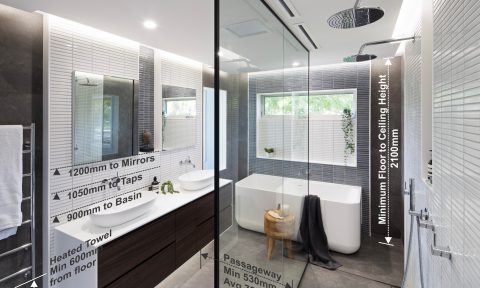The following is an extract from the new book Nature Style, by Alana Langan of Melbourne botanical wares brand Ivy Muse. It’s out later this month.
If you’re like us and have young children, the bathroom might be the one place at home where you can catch a moment to yourself. (Well, sometimes at least!) Here we can restore internal harmony with quiet contemplation and invigorate ourselves, gathering up our reserves for another day in the world. This space is home to some of our most precious wellbeing rituals and plays an important role in a biophilic home. The bathroom is often the smallest and most plainly decorated room in a house, but there are still ways to make it biophilia-friendly without resorting to a complete overhaul.

Houseplants
When it comes to adding greenery to a home, the bathroom should not be overlooked because it’s actually the perfect habitat for indoor plants. Bathrooms provide a warm, humid environment, which mimics the more tropical conditions where the vast majority of indoor plants originate. Finicky indoor plants like ferns are at home here, as are other moisture-loving plants. Common complaints such as fronds with brown, dried tips suddenly become a thing of the past. An added bonus is that plant care becomes a breeze. Simply place your plants in the sink or bath (or taller plants under the shower) for a thorough drenching.

Common concerns like a bathroom with little natural light can be overcome by selecting the right plant from the get-go. A striking Zanzibar gem will thrive in low-light environments and welcome the humidity. A tiny bathroom? Get creative with your use of space. Why not perch a potted plant on a shelf, hang a planter above the bath or simply place a moisture-loving air plant in your shower accessories cavity? Even the smallest touch of greenery will add softness and warmth.
With all their hard surfaces, bathrooms can be stark and sterile in contrast to other rooms, as they are usually devoid of soft furnishings other than a towel or two. Plants can make a real difference, softening the look and feel and ultimately making it a more appealing place to be. Layer the plant life using small plants like hoya on vanities or windowsills, and add bigger options like umbrella trees in plant stands or rubber plants on the floor. If you can fit in a kentia palm or other tall tree like a fiddle leaf fig, go for it – they really help create a luxurious sanctuary vibe.

The big stuff
First up, assess. Where can you add layers, warmth and depth? Modern bathrooms often have clean straight lines so try to mix up the shapes and textures and lean towards organic, curvy forms that reflect those found in nature and that offer contrast. It’s worth focusing efforts on elements that can be retrofitted into your bathroom without too much trouble.
Take a moment to check out your vanity. If it’s constructed from synthetic materials can you replace the top with a more sensual, natural surface like marble or timber? How about the cabinetry? Can it be painted or sanded back to its original state, or new doors or pulls added instead?
Paint is a quick and relatively easy option to update walls and the ceiling. You can even paint the tiles if you’re feeling daring, but make sure you choose tile paint which is purpose-made. Wall treatments including washable wallpaper could be a possibility, depending on how the home and room is decorated already. For example, adding cedar panels to a 70s bathroom could look great. Not only will it fit with the style of the era but the fragrant smell will engage your senses and increase the biophilic effect in the room.

Wall adornments that can withstand bathroom condensation are a big yes too. Think about handmade ceramic sculptures, round or oval mirrors or art made from woven eco-materials such as grasses.
Furniture options in the bathroom are sometimes limited, but even the smallest spaces can benefit from a stool. Try timber for its durability, wondrous feel and scent. We love solid timber or cork stools in particular. They’re a great way to add a sculptural chunk of the outdoors inside. In large bathrooms that can accommodate extra items of furniture – a chair or freestanding cabinet, for instance – choose pieces that include biophilic elements like timber and stone.
And remember, even the smallest touches can have a big impact. A cedar bath mat, for example, is functional and represents a strong connection to nature. It also smells great!
The small details
Choose sensual textures for the bathroom that really engage the senses. Start with quality towels. Natural fibres like Egyptian cotton or linen are the most tactile and comforting – and well worth the splurge in our opinion. Linen and cotton towelling also make great bathrobes.
Scent plays a big role in the bathroom. Be aware of the presence of artificial fragrances and pungent chemicals in your personal care and bathroom cleaning products. Try to use natural and plant-based formulations where possible – the aroma is usually more subtle and reflective of what you might experience outdoors.
Ideally, bathroom surfaces should be styled for functionality, but always make room for at least one or two plants. They provide a pleasant biophilic view while you’re taking a bath or shower.
–Nature Style: Cultivating Wellbeing at Home with Plants by Alana Langan and Jacqui Vidal with photography by Annette O’Brien published by Thames & Hudson. $34.99. Available later this month. Pre-order here.












